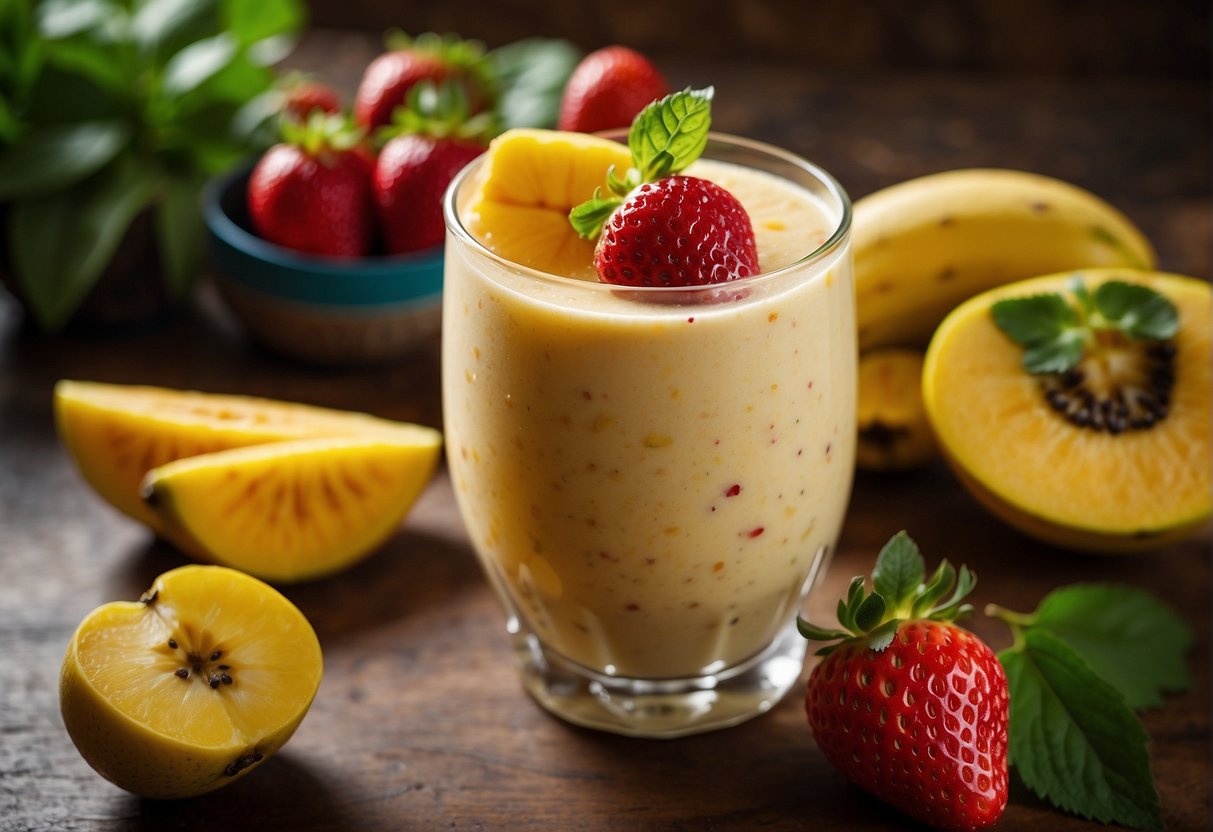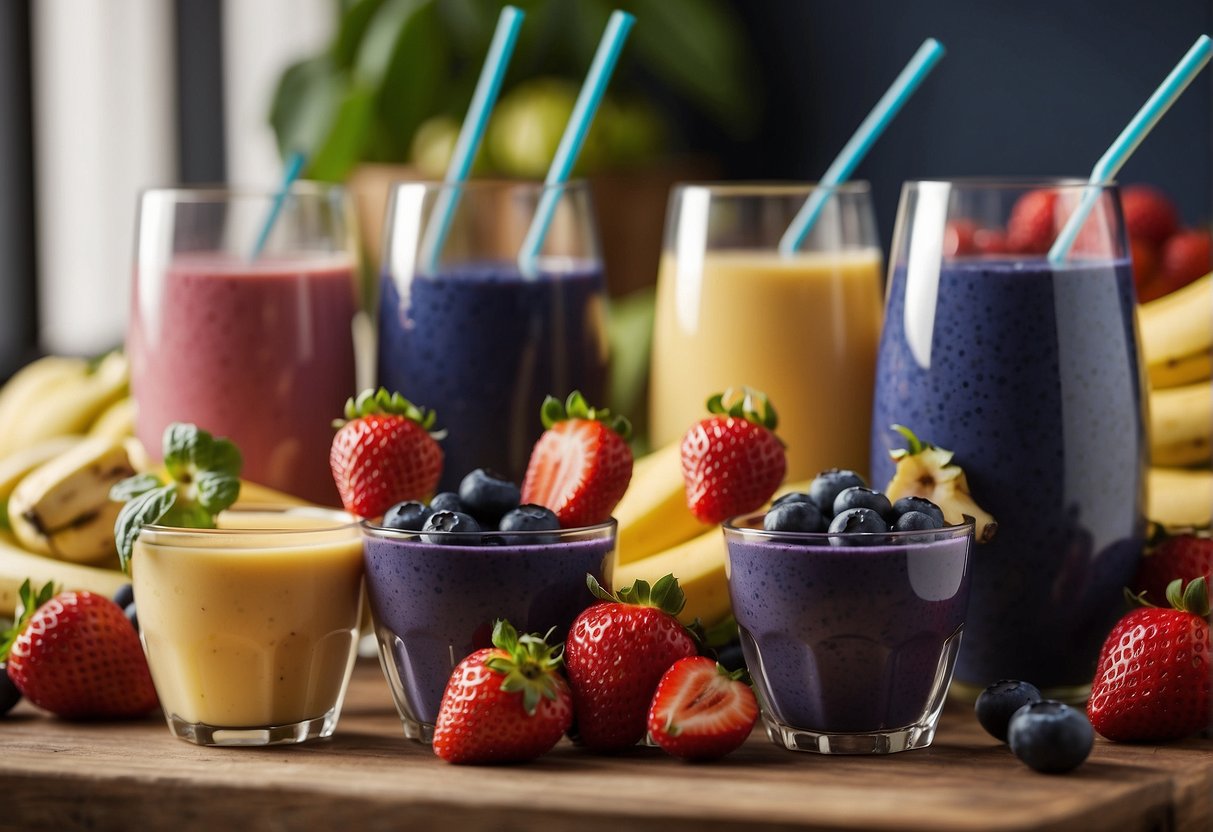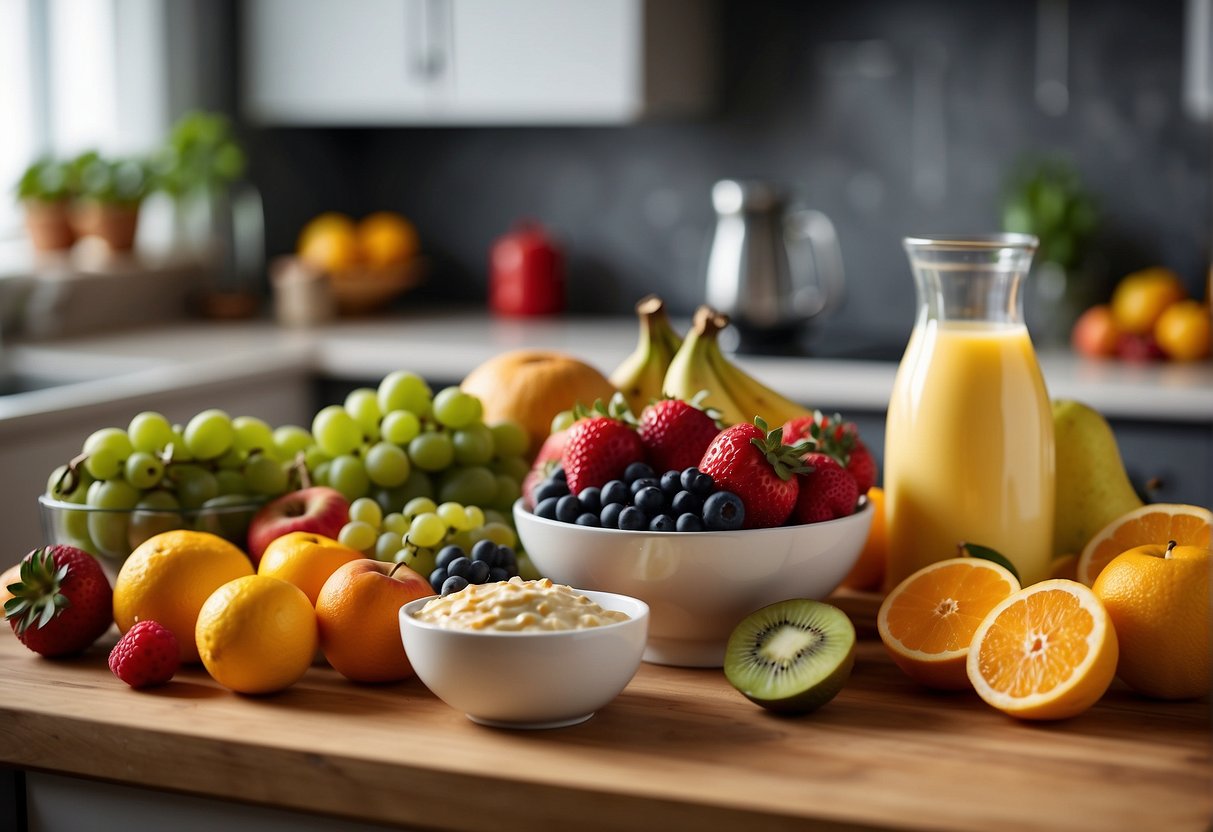Understanding Smoothies
When I think about smoothies, the blend of flavors, textures, and nutritional benefits comes to mind. They’re an all-in-one package of taste and health.
Defining a Smoothie
A smoothie is essentially a blended beverage that I find perfect for any time of the day. It’s a mix of various ingredients, often including fruits, vegetables, and a liquid base, which come together in a thick and creamy consistency. Its versatility is what makes it a staple in my diet.

Components of a Smoothie
The components of a smoothie fall into a few categories:
- Base: This could be water, milk, or even yogurt. The base affects the smoothie’s overall consistency.
- Fruits and Vegetables: They’re the heart of the smoothie, bringing in natural sweetness and essential nutrients. A seasonal smoothie ingredients list & cheat sheet I found suggests using, for instance, tangerine, banana, or kale to take advantage of in-season produce.
- Add-Ins: Options include whole grains for fiber, like oats, seeds for crunch, or avocados for healthy fats.
Role of Blenders in Smoothie Making
Choosing the right blender is crucial for me as it affects the texture of the smoothie. A high-quality blender can effortlessly crush ice and pulverize frozen fruits, ensuring a silky-smooth consistency, which is my personal preference. The power of the blender also impacts how well the ingredients will emulsify, creating a cohesive and enjoyable drink.
Health and Nutrition

I get really excited about the health and nutrition aspects of seasonal fruit smoothies. Not only are they a tasty way to enjoy the bounty of each season, but they pack a punch in terms of vitamins, minerals, and other beneficial nutrients.
Nutritional Benefits
Seasonal fruit smoothies are my go-to for a quick and nutritious meal. They’re naturally rich in fiber, which is great for digestive health, and they provide a variety of vitamins like vitamin C and vitamin A. The natural sugars found in fruits are paired with beneficial fiber, which helps manage blood sugar levels. Also, when I choose fruits that are in season, they’re often more flavorful and nutrient-dense.
Macro and Micro Nutrients
Let’s break down the macros (proteins, fats, and carbohydrates) and micros (vitamins and minerals) in these smoothies. I aim for a balanced intake of macronutrients by adding a source of protein like Greek yogurt or a scoop of protein powder. This way, I get the energy I need without added saturated fats or cholesterol. For micronutrients, leafy greens or berries add iron, potassium is plentiful in bananas, while citrus fruits bump up the vitamin C content. I keep an eye on sodium content by limiting processed ingredients.
Smoothies for Dietary Needs
Crafting smoothies also allows me to tailor my beverage to specific dietary needs. For instance, I can make high-fiber smoothies for digestive health or low-sodium ones if I’m watching my blood pressure. To increase my iron intake, I might add spinach to my blender, which doesn’t affect the taste much. If I need an antioxidant boost, a handful of berries can do the trick. The versatility of smoothies makes it easy for me to adjust my intake of carbs, proteins, and fats depending on my daily nutritional goals.
Seasonal Fruit Selection
When making a smoothie, selecting the right seasonal fruits can really elevate the flavor and nutrition. Let me walk you through the perks and some common picks for each season.
Benefits of Seasonal Fruits
Seasonal fruits not only taste fresher, but they also boast a higher nutritional value since they haven’t been stored for long periods. For example, strawberries and blueberries picked during the peak of summer can have more antioxidants compared to those off-season. Consuming fruits like apples and pomegranate in the fall can provide me with a wealth of nutrients that are at their prime.
Common Seasonal Fruits
- Spring: Ah, the taste of strawberries and carrot in my smoothies is unmatched. Plus, we start seeing mango and pineapple, which bring that tropical vibe.
- Summer: This is when I toss watermelon, berries, and peaches into the blender. They’re just perfect for a refreshing drink on a hot day.
- Fall: I love the depth of flavors from apples, cranberries, and even the sweet pomegranate seeds.
- Winter: Citrus fruits, like blood orange, tangerine, and clementine give me that vitamin C boost when I need it most.
By sticking to what’s in season, I make sure my smoothies are not only delicious but nutritionally optimal.
Smoothie Preparation Techniques

When I make a smoothie, I focus on two main things: picking the freshest ingredients and nailing that creamy, just-right texture.
Choosing the Right Ingredients
I start by ensuring my fruits are in season for the fullest flavor. Whether I’m using berries in summer or citrus in the winter, peak-season fruits make the best base. Next, I decide on the liquid; water is a no-brainer for a lighter drink, but for a richer taste, I might opt for almond milk or coconut milk. If I’m going for an extra protein kick, especially after a workout, I’ll throw in a scoop of my favorite protein powder or add some Greek yogurt for a probiotic boost.
For my vegan friends, I stick to non-dairy ingredients. Yogurt alternatives and various nut milks like almond or coconut milk are my go-tos. Sometimes, I add a tablespoon of chia seeds for extra fiber, or if I’m feeling adventurous, a touch of spirulina for that superfood punch.
Achieving the Perfect Texture
The secret to a creamy smoothie lies in the balance of solids to liquids and the right type of blender. Too much liquid and it’s a drink, too much ice and it’s a sorbet. My rule of thumb is about a cup of liquid—whether it’s juice, milk, or even just water—for every two cups of fruit. Then, I adjust as I blend. Ice is optional, but I usually include a few cubes to make it extra refreshing.
I find that a high-speed blender achieves the best texture, pulverizing everything into a silky-smooth drink. If my smoothie is too thick, I’ll drizzle in a little more liquid until it’s just right. The perfect smoothie texture to me is one that’s smooth enough to sip easily through a straw but thick enough to be satisfying and almost spoonable.
Recipe Variety

In my exploration of smoothie recipes, I’ve come across a delightful variety, from classic fruit smoothies to innovative combinations that tickle the taste buds. Let’s dive into some of the best blends for each category.
Classic Fruit Smoothies
The classic fruit smoothie is a staple in my recipe book. With combinations like strawberry banana or a simple yet delicious peach smoothie, these are my go-to recipes when I want something quick and familiar. A popular favorite is the banana smoothie, which offers a creamy texture that serves as a perfect breakfast or snack.
Green and Veggie Blends
For those of us looking to sneak more veggies into our diet, green smoothie recipes are the answer. I find that spinach or kale can blend seamlessly with fruits like apple or pineapple for a nutrient-packed green smoothie that’s both refreshing and energizing. A kick of ginger or a handful of mint leaves can add an unexpected zing to your sip.
Innovative Combinations
I love getting creative with my blends, like a chocolate banana smoothie for when I crave something sweet or a peanut butter banana smoothie for a satisfying post-workout treat. Exploring tropical flavors brings a burst of sunshine to any day; a tropical smoothie with mango, pineapple, and coconut milk does just the trick. Also, don’t overlook the potential in a watermelon smoothie for a hydrating summer beverage.
Flavor Enhancements

When I’m whipping up a seasonal fruit smoothie, the right flavor enhancements can turn a good drink into a great one. I like to focus on using natural ingredients that boost the taste without drowning out the fresh flavors of the fruit. Here’s how I do it.
Natural Sweeteners
I often reach for honey or maple syrup when my smoothies need a touch of extra sweetness. They’re natural and bring their own unique flavors to the mix. For example, honey adds a floral note which is especially good with berry-based smoothies, while maple syrup has a woodsy taste that complements apple or pumpkin smoothies beautifully.
- Honey: Ideal for enhancing the sweetness level with a floral twist.
- Maple Syrup: Adds a rich, earthy sweetness perfect for autumnal flavors.
Herbs and Spices
Don’t underestimate the power of herbs and spices! A dash of cinnamon can introduce warmth and depth, while mint leaves can offer a refreshing zing which is fantastic in watermelon or citrus smoothies. For a bit of zest, I grate in some ginger, which not only adds a spicy kick but also brings in some great health benefits.
- Cinnamon: Provides a warm and comforting flavor, great with apple and pear smoothies.
- Mint: Offers a burst of cool freshness, excellent in berry and citrus blends.
- Ginger: Delivers a sharp, zesty spice that pairs well with sweeter fruits.
Unique Flavor Additions
Then there are times I want my smoothie to stand out with a unique twist. That’s when I pull out vanilla extract. Just a small splash can make a simple banana smoothie taste like a gourmet treat. And if I’m feeling adventurous, I’ll even add a pinch of non-traditional spices like cardamom or turmeric to really elevate the flavor profile.
- Vanilla Extract: A little goes a long way to add a rich, creamy dimension.
Smoothie Accessories

When I whip up a seasonal fruit smoothie, I like to ensure I’ve got the right accessories on hand. They make prep easier and the smoothie experience much more enjoyable.
Serving Suggestions
For serving, I can’t go without my durable glass smoothie cups. They’re not just sturdy; they showcase the vibrant colors of my smoothie creations. If you’re curious about the style I favor, check out these smoothie cups with their food-grade stainless steel straw included—perfect for sipping and reducing waste.
Eco-Friendly Options
Speaking of waste reduction, I’ve shifted to eco-friendly options wherever possible. For instance, a reusable glass straw adds a touch of class to any smoothie and it’s a kind gesture towards our planet as well. Glass straws, like the ones I’ve gotten into the habit of using, are easy to clean, durable, and don’t add any unwanted flavors to my smoothie. They’re a small step I take towards sustainability in my daily routine.
Dietary Considerations

When I whip up seasonal fruit smoothies, I think about more than just flavor. It’s important to consider various dietary needs and preferences, such as whether a recipe is vegan or allergen-free, and how it fits into a balanced diet. Here’s how I navigate these considerations.
Alternative Diet Recipes
For my vegan friends, I love using plant-based ingredients. Almond butter is a stellar replacement for dairy and adds a creamy texture. I often blend in some oats too; they’re not only vegan but also add a nice thickness to the smoothie. To sweeten things up, a bit of ripe banana does the trick without any honey or dairy-based yogurt.
Balancing Macros
Now, balancing macros isn’t just for the fitness gurus. I find it crucial for turning my smoothie from a simple drink into a filling snack or breakfast. Here’s a quick guide to what I include:
- Carbs: Fruits and veggies. They’re the stars in any smoothie.
- Proteins: A scoop of vegan protein powder, or a tablespoon of peanut butter.
- Fats: A dash of flaxseed or a slice of avocado for those heart-healthy omega-3s.
Allergen-Free Options
Navigating allergens can be tricky, but I’ve got it down to an art. I skip the peanut butter for anyone with nut allergies and opt for sunflower seed butter. Dairy-free is simple: I use almond milk or coconut water instead of cow’s milk. Always sure to check labels for hidden allergens, because keeping my smoothies safe for everyone is a top priority.
Tips and Tricks

When I make my seasonal fruit smoothies, I focus on two things: how to prep them efficiently and keep them as fresh as can be. Here’s how I’ve mastered the art of the perfect smoothie prep and storage.
Making Smoothies Ahead
Batch Prep: I like to pre-portion my fruits and greens and freeze them in individual bags. This not only speeds up my smoothie-making process, but also helps preserve the fruits’ nutrients and consistency. For instance, if I measure out calories, it’s much easier with pre-packed smoothie mixes!
Using Ice Cube Trays: If I’m adding yogurt or coconut water to my smoothies, I sometimes freeze them in ice cube trays. I’ve found that these frozen cubes help thicken the smoothie and keep it cool without diluting the flavor.
Storage and Freshness
Seal it Tight: To keep my smoothies fresh, I store them in airtight containers if I’m not drinking them immediately. This helps maintain the nutrition and taste for up to 24 hours.
Refrigeration Tips: I’ve noticed that filling the containers to the brim and sealing them well reduces oxidation. It’s my go-to method for ensuring my smoothie doesn’t separate or get that weird layer on top.
Remember, a great smoothie isn’t just about tossing stuff in the blender; it’s about thoughtfulness and a little bit of prep!
Health-Driven Smoothie Trends
I’ve noticed that smoothies aren’t just a tasty treat anymore; they’ve evolved into powerful vehicles for health and wellness. Whether I’m looking to cleanse my system, boost my energy, or manage my weight, there’s a smoothie trend out there that fits my needs.
Detox and Cleansing Smoothies
Detox smoothies often incorporate ingredients like kale and spinach, combined with other veggies and fruits known for their cleansing properties. I find them to be a delicious way to get my fill of fiber, antioxidants, and important vitamins, guiding my body’s natural detox pathways. One popular combination I’ve tried includes kale and cucumber with a splash of lemon juice.
Energy-Boosting Recipes
When I need an extra kick to get my day going or power through a workout, I turn to smoothies with a balance of natural sugars, protein, and complex carbohydrates. Ingredients like bananas for potassium, nutritious greens, and a scoop of nut butter do wonders for my energy levels. For a tropical twist, I’ll add some orange or pineapple, inspired by Mango Piña Colada Smoothies.
Weight Management Blends
Managing weight is as much about flavor as it is about nutrition for me, which is why I love fruit smoothies packed with fiber and protein that help me feel full. For weight management, I look to blends with low-calorie fruits, plenty of greens, and a base of almond or coconut milk. A personal favorite is blending some strawberries with banana and a hint of almond milk, similar to the Strawberry-Blueberry-Banana Smoothie I found online.
Frequently Asked Questions
Delving into the world of homemade fruit smoothies, I often get asked about the best fruit combos and tips for making a delicious and nutritious blend. Here’s a roundup of the most common questions I encounter.
What are some tasty combinations of fruits for homemade smoothies?
For a refreshing and flavorful smoothie, I love to combine classics like strawberry and banana or go tropical with mango, pineapple, and a squeeze of lime. The natural sweetness and vibrant colors make any day feel like summer.
Can you suggest any fruit smoothie recipes that are both delicious and healthy?
Absolutely! A great choice is a blueberry cinnamon smoothie; it’s packed with antioxidants, protein, and warm spices that not only taste amazing but also offer lasting energy.
Which fruits are best avoided when making a smoothie, and why?
I tend to skip adding too much of fruits like figs or overly ripe bananas to my smoothies because they can make them too sweet and high in calories. Achieving a balance of taste and nutrition is key.
What are the top fruit choices to include in a weight loss smoothie?
For weight-loss friendly smoothies, I stick to low-calorie fruits like berries, apples, and peaches. These fruits keep the calorie count down and are high in fiber, which helps keep me full longer.
How do I make a smoothie using fresh, seasonal fruits?
It’s simple! When fruits like berries or peaches are in season, I wash, chop, and freeze them in single layers as described in The Art of Seasonal Smoothies. This method keeps them fresh and ready to use in smoothies anytime.
Could you share some beginner-friendly tips for creating fresh fruit smoothies?
Certainly. Start with a solid base of ripe, flavorful fruits. If you’re unsure where to begin, Green smoothies FAQs offer great advice on combinations and techniques. Don’t be afraid to experiment and find what flavors you enjoy the most.

